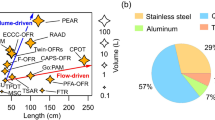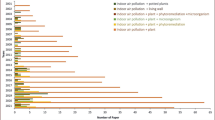Abstract
The accumulation of volatile organic compounds (VOCs) in ambient air affects air quality through the generation of surface level ozone and secondary organic aerosol. A study of the distribution and source apportionment of VOCs was conducted at two stations to investigate the air quality status of Kuala Lumpur. Samples of ambient air were collected into Tedlar sampling bags using an air sampling pump and then pre-concentrated with solid-phase micro-extraction fibre. Gas chromatography–mass spectrometry (GC–MS) was employed to measure the VOC species. An absolute principal component score–multiple linear regression (APCS–MLR) model was then applied to identify the possible source contributions of VOCs. Seventeen VOCs were detected, and methylene chloride (243 ± 241 ppbv) was the most abundant species at both stations. Within the benzene, toluene, ethyl benzene and xylene group of VOCs, toluene was dominant with an average of 135 ± 202 ppbv, followed by p-xylene (41.3 ± 24.7 ppbv), ethyl benzene (34.0 ± 32.6 ppbv) and benzene (18.2 ± 12.9 ppbv). A strong correlation between benzene and toluene (p < 0.01, r = 0.65) indicated the influence of motor vehicle emissions during the sampling period. The APCS–MLR results indicated that the source contributors for VOCs at the sampling stations were gasoline evaporation (31 %), motor vehicle exhaust/solvent (22 %), motor vehicle emissions (21 %), petrol pump/solvent usage (15 %) and industrial emissions (10 %).





Similar content being viewed by others
References
An J, Zhu B, Wang H, Li Y, Lin X, Yang H (2014) Characteristics and source apportionment of VOCs measured in an industrial area of Nanjing, Yangtze River Delta, China. Atmos Environ 97:206–214. doi:10.1016/j.atmosenv.2014.08.021
Anderson MJ, Daly EP, Miller SL, Milford JB (2002) Source apportionment of exposures to volatile organic compounds: II. Application of receptor models to TEAM study data. Atmos Environ 36:3643–3658. doi:10.1016/S1352-2310(02)00280-7
Atkinson R (2000) Atmospheric chemistry of VOCs and NOx. Atmos Environ 34:2063–2101. doi:10.1016/S1352-2310(99)00460-4
Atkinson R, Arey J (2003) Gas-phase tropospheric chemistry of biogenic volatile organic compounds: a review. Atmos Environ 37(Supplement 2):197–219. doi:10.1016/S1352-2310(03)00391-1
Badami M (2005) Transport and urban air pollution in India. Environ Manag 36:195–204. doi:10.1007/s00267-004-0106-x
Bae M-S, Schauer JJ, DeMinter JT, Turner JR (2004) Hourly and daily patterns of particle-phase organic and elemental carbon concentrations in the urban atmosphere. J Air Waste Manag As 54:823–833. doi:10.1080/10473289.2004.10470957
Bari MA, Kindzierski WB, Wheeler AJ, Héroux M-È, Wallace LA (2015) Source apportionment of indoor and outdoor volatile organic compounds at homes in Edmonton, Canada. Build Environ 90:114–124. doi:10.1016/j.buildenv.2015.03.023
Barletta B, Meinardi S, Simpson IJ, Zou S, Rowland FS, Blake DR (2008) Ambient mixing ratios of nonmethane hydrocarbons (NMHCs) in two major urban centers of the Pearl River Delta (PRD) region: Guangzhou and Dongguan. Atmos Environ 42:4393–4408. doi:10.1016/j.atmosenv.2008.01.028
Blanchard CL, Tanenbaum S, Lawson DR (2008) Differences between weekday and weekend air pollutant levels in Atlanta; Baltimore; Chicago; Dallas-Fort Worth; Denver; Houston; New York; Phoenix; Washington, DC; and Surrounding Areas. J Air Waste Manag As 58:1598–1615. doi:10.3155/1047-3289.58.12.1598
Brock CA et al (2003) Particle growth in urban and industrial plumes in Texas. J Geophys Res Atmos 108:4111. doi:10.1029/2002JD002746
Brown SG, Frankel A, Hafner HR (2007) Source apportionment of VOCs in the Los Angeles area using positive matrix factorization. Atmos Environ 41:227–237. doi:10.1016/j.atmosenv.2006.08.021
Cetin E, Odabasi M, Seyfioglu R (2003) Ambient volatile organic compound (VOC) concentrations around a petrochemical complex and a petroleum refinery. Sci Total Environ 312:103–112. doi:10.1016/S0048-9697(03)00197-9
Chen J et al (2009) Characteristics of gaseous pollutants near a main traffic line in Beijing and its influencing factors. Atmos Res 94:470–480. doi:10.1016/j.atmosres.2009.07.008
Chinkin LR, Coe DL, Funk TH, Hafner HR, Roberts PT, Ryan PA, Lawson DR (2003) Weekday versus weekend activity patterns for ozone precursor emissions in California’s South Coast Air Basin. J Air Waste Manag As 53:829–843. doi:10.1080/10473289.2003.10466223
Draxler RR, Rolph GD (2014) HYSPLIT (HYbrid Single-Particle Lagrangian Integrated Trajectory), NOAA Air Resources Laboratory, College Park. http://www.arl.noaa.gov/HYSPLIT.php.
Durmusoglu E, Taspinar F, Karademir A (2010) Health risk assessment of BTEX emissions in the landfill environment. J Hazard Mater 176:870–877. doi:10.1016/j.jhazmat.2009.11.117
Ee-Ling O, Mustaffa NIH, Amil N, Khan MF, Latif MT (2015) Source contribution of PM2.5 at different locations on the Malaysian peninsula. Bull Environ Contam Toxicol 94:537–542. doi:10.1007/s00128-015-1477-9
Gaarenstroom PD, Perone SP, Moyers JL (1977) Application of pattern recognition and factor analysis for characterization of atmospheric particulate composition in southwest desert atmosphere. Environ Sci Technol 11:795–800. doi:10.1021/es60131a003
Gee IL, Sollars CJ (1998) Ambient air levels of volatile organic compounds in Latin American and Asian cities. Chemosphere 36:2497–2506. doi:10.1016/S0045-6535(97)10217-X
Guo H, Wang T, Simpson IJ, Blake DR, Yu XM, Kwok YH, Li YS (2004) Source contributions to ambient VOCs and CO at a rural site in eastern China. Atmos Environ 38:4551–4560. doi:10.1016/j.atmosenv.2004.05.004
Guo H, Cheng HR, Ling ZH, Louie PKK, Ayoko GA (2011) Which emission sources are responsible for the volatile organic compounds in the atmosphere of Pearl River Delta? J Hazard Mater 188:116–124. doi:10.1016/j.jhazmat.2011.01.081
Ho KF, Lee SC, Guo H, Tsai WY (2004) Seasonal and diurnal variations of volatile organic compounds (VOCs) in the atmosphere of Hong Kong. Sci Total Environ 322:155–166. doi:10.1016/j.scitotenv.2003.10.004
Hopke PK, Gladney ES, Gordon GE, Zoller WH, Jones AG (1976) The use of multivariate analysis to identify sources of selected elements in the Boston urban aerosol. Atmos Environ (1967) 10:1015–1025. doi:10.1016/0004-6981(76)90211-0
Hopke PK, Barrie LA, Li SM, Cheng MD, Li C, Xie Y (1995) Possible sources and preferred pathways for biogenic and non-sea-salt sulfur for the high Arctic. J Geophys Res 100:16595–16603. doi:10.1029/95JD01712
Kalabokas PD, Hatzianestis J, Bartzis JG, Papagiannakopoulos P (2001) Atmospheric concentrations of saturated and aromatic hydrocarbons around a Greek oil refinery. Atmos Environ 35:2545–2555. doi:10.1016/S1352-2310(00)00423-4
Khan MF, Hirano K, Masunaga S (2010) Quantifying the sources of hazardous elements of suspended particulate matter aerosol collected in Yokohama. Jpn Atmos Environ 44:2646–2657
Khan MF, Latif MT, Amil N, Juneng L, Mohamad N, Nadzir MSM, Hoque HMS (2015) Characterization and source apportionment of particle number concentration at a semi-urban tropical environment. Environ Sci Pollut Res 22:13111–13126. doi:10.1007/s11356-015-4541-4
Kim K-H et al (2012) Volatile organic compounds in ambient air at four residential locations in Seoul, Korea. Environ Eng Sci 29:875–889. doi:10.1089/ees.2011.0280
Kim K, Chun H-H, Jo W (2015) Multi-year evaluation of ambient volatile organic compounds: temporal variation, ozone formation, meteorological parameters, and sources. Environ Monit Assess 187:1–12. doi:10.1007/s10661-015-4312-1
Kuo C-P, Liao H-T, Chou CCK, Wu C-F (2014) Source apportionment of particulate matter and selected volatile organic compounds with multiple time resolution data. Sci Total Environ 472:880–887. doi:10.1016/j.scitotenv.2013.11.114
Lee SC, Chiu MY, Ho KF, Zou SC, Wang X (2002) Volatile organic compounds (VOCs) in urban atmosphere of Hong Kong. Chemosphere 48:375–382. doi:10.1016/S0045-6535(02)00040-1
Lin T-Y, Sree U, Tseng S-H, Chiu KH, Wu C-H, Lo J-G (2004) Volatile organic compound concentrations in ambient air of Kaohsiung petroleum refinery in Taiwan. Atmos Environ 38:4111–4122. doi:10.1016/j.atmosenv.2004.04.025
Liu C, Xu Z, Du Y, Guo H (2000) Analyses of volatile organic compounds concentrations and variation trends in the air of Changchun, the northeast of China. Atmos Environ 34:4459–4466. doi:10.1016/S1352-2310(00)00102-3
Liu P-WG, Yao Y-C, Tsai J-H, Hsu Y-C, Chang L-P, Chang K-H (2008) Source impacts by volatile organic compounds in an industrial city of southern Taiwan. Sci Total Environ 398:154–163. doi:10.1016/j.scitotenv.2008.02.053
Loreto F, Fares S (2013) Biogenic volatile organic compounds and their impacts on biosphere–atmosphere interactions. Climate Change, air pollution and global challenges: knowledge, understanding and perspectives from forest research, Elsevier Physical Sciences Series “Developments in Environmental Science” vol 13, pp 57–68
Majumdar D, Mukherjee AK, Sen S (2009) Apportionment of sources to determine vehicular emission factors of BTEX in Kolkata, India. Water Air Soil Pollut 201:379–388. doi:10.1007/s11270-008-9951-1
McCarthy MC, Aklilu Y-A, Brown SG, Lyder DA (2013) Source apportionment of volatile organic compounds measured in Edmonton, Alberta. Atmos Environ 81:504–516. doi:10.1016/j.atmosenv.2013.09.016
Mishra N, Bartsch J, Ayoko GA, Salthammer T, Morawska L (2015) Volatile organic compounds: characteristics, distribution and sources in urban schools. Atmos Environ 106:485–491. doi:10.1016/j.atmosenv.2014.10.052
Murphy BL, Morrison RD (2007) Introduction to environmental forensics. Academic Press, London
Mustaffa N, Latif M, Ali M, Khan M (2014) Source apportionment of surfactants in marine aerosols at different locations along the Malacca Straits. Environ Sci Pollut Res 21:6590–6602. doi:10.1007/s11356-014-2562-z
Nguyen HT, Kim K-H, Kim M-Y (2009) Volatile organic compounds at an urban monitoring station in Korea. J Hazard Mater 161:163–174. doi:10.1016/j.jhazmat.2008.03.066
Pandey K, Sahu L (2014) Emissions of volatile organic compounds from biomass burning sources and their ozone formation potential over India. Curr Sci 106:1270
Parra MA, Elustondo D, Bermejo R, Santamaría JM (2009) Ambient air levels of volatile organic compounds (VOC) and nitrogen dioxide (NO2) in a medium size city in Northern Spain. Sci Total Environ 407:999–1009. doi:10.1016/j.scitotenv.2008.10.032
Pekey B, Yılmaz H (2011) The use of passive sampling to monitor spatial trends of volatile organic compounds (VOCs) at an industrial city of Turkey. Microchem J 97:213–219. doi:10.1016/j.microc.2010.09.006
Sosa ER, Bravo AH, Mugica AV, Sanchez AP, Bueno LE, Krupa S (2009) Levels and source apportionment of volatile organic compounds in southwestern area of Mexico City. Environ Pollut 157:1038–1044. doi:10.1016/j.envpol.2008.09.051
Sahu L (2012) Volatile organic compounds and their measurements in the troposphere. Curr Sci 102:1645–1649
Sahu LK, Saxena P (2015) High time and mass resolved PTR-TOF-MS measurements of VOCs at an urban site of India during winter: role of anthropogenic, biomass burning, biogenic and photochemical sources. Atmos Res 164–165:84–94. doi:10.1016/j.atmosres.2015.04.021
Schauer JJ, Cass GR (2000) Source apportionment of wintertime gas-phase and particle-phase air pollutants using organic compounds as tracers. Environ Sci Technol 34:1821–1832. doi:10.1021/es981312t
Shen X, Zhao Y, Chen Z, Huang D (2013) Heterogeneous reactions of volatile organic compounds in the atmosphere. Atmos Environ 68:297–314. doi:10.1016/j.atmosenv.2012.11.027
Srivastava A (2005) Variability in voc concentrations in an urban area of Delhi. Environ Monit Assess 107:363–373. doi:10.1007/s10661-005-3546-8
Srivastava A, Joseph AE, Devotta S (2006) Volatile organic compounds in ambient air of Mumbai—India. Atmos Environ 40:892–903. doi:10.1016/j.atmosenv.2005.10.045
Thurston GD, Spengler JD (1985) A quantitative assessment of source contributions to inhalable particulate matter pollution in metropolitan Boston. Atmos Environ 19:9–25. doi:10.1016/0004-6981(85)90132-5
Thurston GD, Ito K, Lall R (2011) A source apportionment of U.S. fine particulate matter air pollution. Atmos Environ 45:3924–3936
Tiwari V, Hanai Y, Masunaga S (2010) Ambient levels of volatile organic compounds in the vicinity of petrochemical industrial area of Yokohama. Jpn Air Qual Atmos Health 3:65–75. doi:10.1007/s11869-009-0052-0
Tran NK, Steinberg SM, Johnson BJ (2000) Volatile aromatic hydrocarbons and dicarboxylic acid concentrations in air at an urban site in the Southwestern US. Atmos Environ 34:1845–1852. doi:10.1016/S1352-2310(99)00071-0
Tsai WY, Chan LY, Blake DR, Chu KW (2006) Vehicular fuel composition and atmospheric emissions in South China: Hong Kong, Macau, Guangzhou, and Zhuhai. Atmos Chem Phys 6:3281–3288
Yamamoto N, Okayasu H, Murayama S, Mori S, Hunahashi K, Suzuki K (2000) Measurement of volatile organic compounds in the urban atmosphere of Yokohama, Japan, by an automated gas chromatographic system. Atmos Environ 34:4441–4446. doi:10.1016/S1352-2310(00)00168-0
Acknowledgments
The authors would like to thank the Ministry of Education for Research Grant FRGS/1/2013/STWN01/UKM/02/2. Many thanks to Universiti Kebangsaan Malaysia for Research University grants DIP-2014-005 and AP-2015-010. Special thanks to Dr Rose Norman for assistance with the proofreading of this manuscript.
Author information
Authors and Affiliations
Corresponding author
Rights and permissions
About this article
Cite this article
Hosaini, P.N., Khan, M.F., Mustaffa, N.I.H. et al. Concentration and source apportionment of volatile organic compounds (VOCs) in the ambient air of Kuala Lumpur, Malaysia. Nat Hazards 85, 437–452 (2017). https://doi.org/10.1007/s11069-016-2575-7
Received:
Accepted:
Published:
Issue Date:
DOI: https://doi.org/10.1007/s11069-016-2575-7




